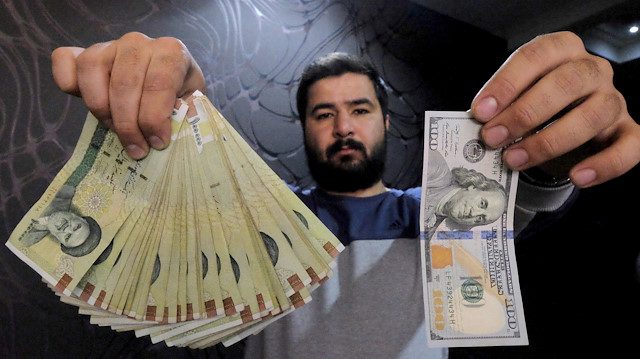
The Iranian rial was trading at 217,000 (buy) and 218,000 (sell) on unofficial market on Sunday
There is a palpable buzz at Ferdowsi Square, one of the busiest intersections in the Iranian capital and the hub of foreign exchange market, these days. However, not many happy faces can be seen.
The Iranian currency, rial, continues to lose its value against the US dollar, touching a record low every day. The impact of COVID-19 can be clearly seen on the financial market.
The rial was trading at 217,000 (buy) and 218,000 (sell) on the unofficial market on Sunday, prompting many money exchange shops to down their shutters.
In the past two weeks, the rial has continued to slide, dropping from 171,000 to 217,000. The sharp dip in its value comes as the country battles the new surge in the pandemic.
Previously, the record low was 190,000 in September 2018, a few months after the US re-imposed sanctions on Iran, when the rial lost around 70 percent of its value against US dollar.
According to market analysts, 217,000 is the lowest ever rate of rial against US dollar.
In Iran, the local currency comes with official and unofficial rates. The official rate set by the state-owned Central Bank of Iran (CBI) was 42,000 on Sunday, unchanged from two weeks ago.
In May, the Iranian parliament had approved a bill to introduce overhaul in the country’s currency. It said the forex rates would be determined by Iran’s currency reserves and the CBA would introduce rates based on the dominant foreign currency system.
It also sought to slash the extra zeroes and reverse the currency to what it was a century ago, from rial to toman, with each toman equal to 10,000 rials.
- Freefall
While the rial has quietly nosedived since September 2018, at times it has seen dramatic falls and recoveries. Its value is now four times less than what it was at the beginning of 2018.
Around the time when Iran and the US administration of former President Barack Obama signed a nuclear deal in 2015, providing relief from some sanctions, rial traded at about 35,000.
Between 2015 and 2020, Iran’s currency has seen over 500 percent loss in value against the US dollar.
The US withdrawal from the nuclear deal in May 2018, followed by re-imposition of sanctions, was a key trigger for the plunge of Iran’s currency, believe experts.
In the last four months, since the outbreak of coronavirus in Iran, the rial has plummeted further, from around 15,000 to over 217,000.
Iran’s economic outlook has been hit hard by the pandemic, with estimated $2.5 billion losses incurred over the past four months, according to government reports.
The country’s gross domestic product (GDP) has also shrunk by 15 percent, Iran’s Finance Minister Farhad Dejpasand told parliament last week.
CBI chief Abdolnaser Hemmati tried to allay the concerns, saying the unfavorable situation created by the coronavirus pandemic and the pressure on the foreign exchange market should not give a “wrong signal”.
Hemmati said CBA is trying to restore stability in the market by recovering the billions of dollars frozen funds overseas. According to Iranian officials, billions of dollars revenue from crude oil exports continues to be frozen overseas due to the US sanctions.
According to Amin Sabooni, an economic analyst and editor at Iran’s leading business newspaper Financial Tribune, multiple factors are responsible for the rial’s freefall.
“The complete loss of export revenue, lawlessness of exporters and importers, dollarization of the economy and the US sanctions are some of the factors flogging the rial,” he told Anadolu Agency.
Sabooni hastened to add that any recovery is a “long shot”. “Things could get much worse before they get better,” he said.
Hello, the comments you share on our site are a valuable resource for other users. Please respect other users and different opinions. Do not use rude, offensive, derogatory, or discriminatory language.
The floor is all yours.








